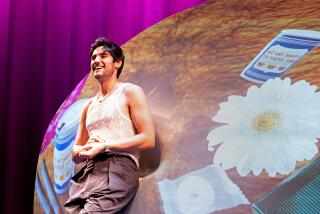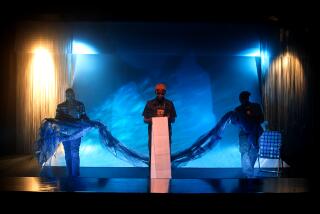Opening Up to Explore Racist, Sexist Topics in ‘HOWL’ : * Performance art: Writer-director Keith Antar Mason explores oppression of African-American men.
- Share via
Keith Antar Mason is talking about people not talking: “Black men are suffering from the No. 1 killer. Black male silence.”
As a director-writer-performance artist known for tackling racism and other social ills in an unflinching way, Mason has decided to open the discussion about the personal and sexual oppression of African-American men.
“There’s a lot of conservatism going on in the African-American community,” he says. “I wanted to do a piece that would be straightforward and honest about the struggles we go through to have relationships, how men struggle to be with black women and that would confront racism in the white men’s movement.”
His “HOWL: (the small case of the missing cockhound)” plays Friday through Sunday at Los Angeles Contemporary Exhibitions, as part of the Multi-Mini-Mondo Festival 1991, a co-production of the Cactus Foundation, Tearsheets Productions and the Hittite Empire, an African-American performance collective Mason founded in 1985.
Cast in a noir mode Mason likens to a Chester Himes novel, “HOWL” looks at the issues surrounding intimate relationships between African-American men and women. It is the most theater-like of his performance artworks yet, complete with a linear narrative, a single setting and distinct characters portrayed by a cast of seven Hittites.
Mason, who also writes plays, is known for his “. . . for black boys who have considered homicide when the streets were too much . . . ,” which in 1982 won him playwright of the year from the Midwest Black Theater Conference. His recent performance works have included a piece about the black Secret Service agent who was shot protecting President Ronald Reagan, and another about the so-called “wilding” incident in New York’s Central Park.
With that penchant for volatile issues as a prelude, two sources prompted Mason toward this new work. The first was an occurence at a recent black choreographers festival. “Here is this hip, chic, urban black audience,” Mason says. “(The choreographer-dancer) removes his clothing, and some of the audience gets up and walks out in a huff. It hit home to me, the issue of sexual repression in the black community.”
The other thorn in Mason’s artistic side is the Robert Bly school of male empowerment. “I don’t believe the way to deep masculinity is through the path of ‘deep grief,’ as Bly has said. The political reality of African-Americans (is such that) we understand that grief already.”
Instead, says Mason, African-American men need a way to talk about their experiences apart from the language of the men’s movement, which has been dominated by white, middle-class males. “We need our own symbols to help us understand the path to deep masculinity,” Mason says.
Part and parcel of that masculinity is sexuality, and that is an area in which Mason feels the African-American psyche has been most deeply scarred. “Black men . . . understand that their sexuality is a gift,” he says. “Then, because of racism and heterosexism, our masculinity becomes the property of the state, a threat to society.”
That attitude is then translated into slurs. “Those words need to be stricken from the language. Black men (must) break black male silence and say, ‘Don’t call me that, that hurts me.’
“We’re taught by society not to respect ourselves, taught by teachers who don’t expect us to achieve. Spirituality is a part of the black male existence that is never illustrated. Being happy is a true part of our being, but we don’t get depicted that way. The media doesn’t get beyond this gangster-rap-tough guy image.”
Fortunately, though, not all media is so myopic.
Mason, who’s jokingly referred to by fellow Hittites as the “Spike Lee of the performance art world,” sees a connection between himself and the currently controversial filmmaker, whose work he praises.
“We’ve each done a piece that deals with relationships at the same time,” Mason says. “For me, the scene (in ‘Jungle Fever’) where the women sit around and grapple with the reality that there aren’t enough black men is the most horrific image in the film.
“I’m dealing with the idea that there are plenty of black men, but that it’s difficult for us to find a relationship where we can truly be ourselves. It’s painful to open oneself up to feelings. It’s even more frightening to communicate them to someone.”
More to Read
The biggest entertainment stories
Get our big stories about Hollywood, film, television, music, arts, culture and more right in your inbox as soon as they publish.
You may occasionally receive promotional content from the Los Angeles Times.










